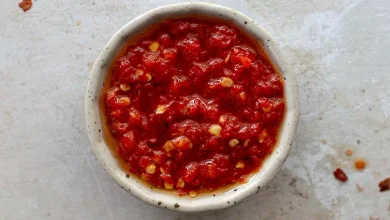🍑 Apricot Basting Sauce 🍑
Apricot basting sauce is a delightful and flavorful condiment used in cooking, especially for grilling, roasting, or glazing meats and poultry. It adds a sweet and tangy taste to dishes and is known for its versatility. Here’s a detailed breakdown of this delicious sauce:
📜 History:
Apricot basting sauce has its roots in traditional cooking techniques, particularly in the Mediterranean and Middle Eastern cuisines. The combination of apricots with various spices and seasonings has been used for centuries to enhance the flavors of meats and create a harmonious blend of sweet and savory tastes.
🧪 Components:
- Apricots: Fresh or dried apricots are the star ingredient, providing a natural sweetness and a hint of tartness.
- Liquid: You can use various liquids, including water, white wine, or chicken broth, to create the base of the sauce.
- Sweetener: Sugar or honey is added to enhance the sweetness of the apricots.
- Acidity: Lemon juice or vinegar brings a tangy balance to the sauce.
- Spices: Common spices include ginger, cinnamon, and cloves, which add depth and complexity.
- Seasonings: Salt and pepper are essential to season the sauce to taste.
👩🍳 Steps to Prepare:
Here’s a basic recipe for apricot basting sauce:
Ingredients:
- 1 cup apricots (dried or fresh)
- 1/2 cup water
- 1/4 cup sugar or honey
- 2 tablespoons lemon juice
- 1/2 teaspoon ginger (ground)
- 1/4 teaspoon cinnamon
- Salt and pepper to taste
Instructions:
- Prepare the apricots: If using dried apricots, soak them in warm water for about 30 minutes until they soften. If using fresh apricots, remove the pits and chop them into small pieces.
- Cook the sauce: In a saucepan, combine the apricots, water, sugar or honey, lemon juice, ginger, and cinnamon. Bring to a simmer over medium heat.
- Simmer and reduce: Reduce the heat to low and let the mixture simmer for about 15-20 minutes, stirring occasionally. The sauce should thicken and the apricots will become soft and mushy.
- Season: Season the sauce with salt and pepper to taste. Adjust the sweetness and acidity to your liking by adding more sugar or lemon juice if needed.
- Blend (optional): For a smoother texture, you can use an immersion blender or a regular blender to puree the sauce until it’s smooth.
- Use as a basting sauce: Allow the sauce to cool slightly before using it to baste your meat or poultry while grilling or roasting. You can also use it as a glaze during the last few minutes of cooking.
⏱️ Time Needed:
The preparation time for apricot basting sauce may vary depending on whether you use fresh or dried apricots and your cooking skills. On average, it takes about 30-40 minutes to make this sauce from start to finish.
Enjoy the sweet and tangy goodness of apricot basting sauce in your culinary creations! 🍽️👨🍳
Certainly, here are the nutrition facts and some health information for apricot basting sauce:
Nutrition Facts (per serving, approximately 2 tablespoons):
- Calories: 40-50 calories
- Total Fat: 0 grams
- Cholesterol: 0 milligrams
- Sodium: 0-5 milligrams (depending on salt added)
- Total Carbohydrates: 10-12 grams
- Dietary Fiber: 0-1 gram
- Sugars: 9-10 grams
- Protein: 0 grams
Health Information:
-
Low in Fat: Apricot basting sauce is naturally low in fat, which makes it a healthier choice compared to some other sauces.
-
Low Sodium: If you control the amount of salt added, you can keep the sodium content low. This is beneficial for those watching their sodium intake.
-
Source of Vitamin C: Apricots used in the sauce provide a good dose of vitamin C, an antioxidant that supports the immune system and overall health.
-
Moderate Sugar: While the sauce does contain sugar from the apricots and sweetener, it’s typically moderate and can be adjusted to your preference. Keep in mind that excessive sugar intake should be moderated in a balanced diet.
-
Natural Ingredients: Apricot basting sauce is made from natural ingredients, especially when you use fresh apricots and limit the use of processed sweeteners. This can make it a healthier choice compared to commercially processed sauces with additives.
-
Versatile Use: You can control the ingredients and adjust the sauce to meet your dietary preferences. For example, you can use honey as a natural sweetener or reduce the sugar content for a lower-calorie option.
Remember that the exact nutrition content may vary based on the specific recipe and ingredients you use, so it’s a good idea to check the labels if you’re concerned about specific dietary needs or restrictions.



